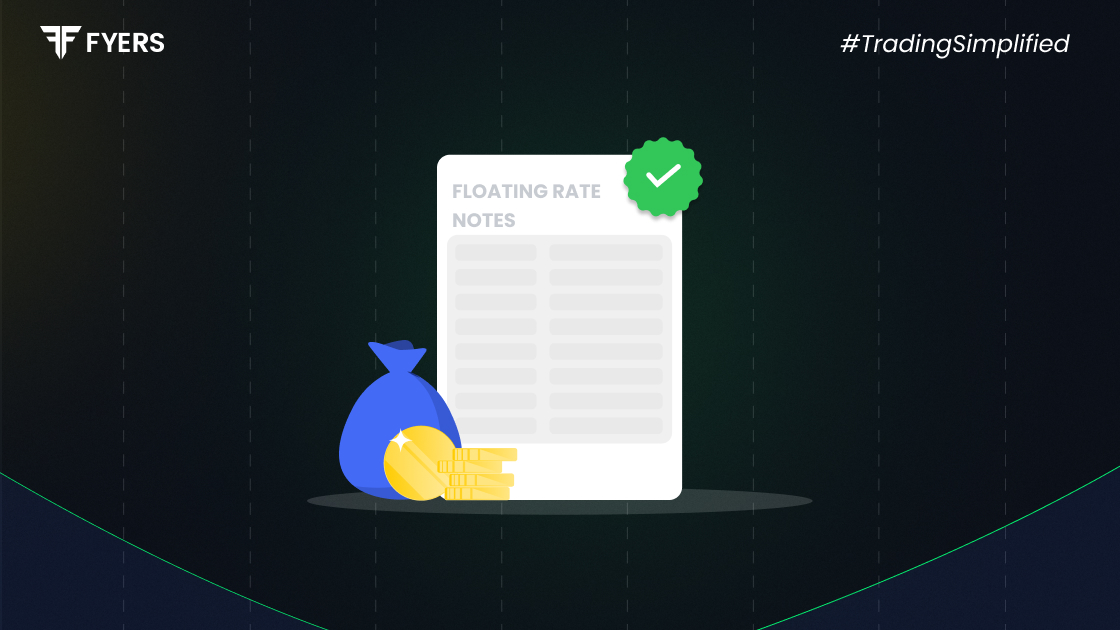

 29 Aug, 2025
29 Aug, 2025
 5 mins read
5 mins read

Investors looking for a balance between stability and income often consider bonds. One such instrument that adapts to market conditions better than fixed-rate bonds is the Floating Rate Note (FRN). With interest rates fluctuating globally, FRNs have gained attention for their flexibility and potential to hedge against rate volatility.
In this blog, we’ll break down what floating rate notes are, how they work, their types, benefits, and risks-so you can decide if they fit into your fixed-income investment strategy.
A floating rate note is a type of debt instrument with a variable interest rate that adjusts periodically. Unlike traditional fixed-rate bonds, the interest or coupon on an FRN resets in line with a benchmark rate-such as the MCLR (Marginal Cost of Lending Rate) in India or LIBOR overseas-plus a fixed spread.
This makes floating rate bonds particularly attractive when interest rates are rising, as investors receive higher interest payments over time.
Floating rate bonds usually have:
Face value: The principal amount repaid at maturity.
Coupon rate: Not fixed; it’s expressed as “benchmark + spread”. For example, MCLR + 2%.
Reset frequency: The rate typically resets every 3 to 6 months.
Maturity: Generally ranges from 2 to 5 years, but this may vary.
Let’s say you buy an FRN with a face value of ₹1,000 at a spread of 1.5% over a benchmark that currently stands at 6%. Your first coupon rate would be 7.5%. If the benchmark rises to 6.5% at the next reset, your interest will increase to 8%.
FRNs come in various formats to suit different risk profiles and investment goals:
|
Type |
Description |
|---|---|
|
Plain Vanilla FRN |
Interest resets at regular intervals based on a benchmark rate. |
|
Step-up FRN |
The spread increases over time to compensate for longer maturity. |
|
Capped FRN |
Has a maximum coupon limit, even if the benchmark rises. |
|
Floored FRN |
Has a minimum coupon limit, protecting against falling rates. |
|
Inverse FRN |
Interest rate moves in the opposite direction of the benchmark. |
Despite their flexibility, FRNs carry certain risks:
Interest rate risk: While FRNs benefit from rising rates, they offer lower returns when rates fall.
Credit risk: If the issuer defaults, you could lose your capital or miss interest payments.
Liquidity risk: FRNs are not as actively traded as other bonds, which may make them harder to sell quickly.
Complex structure: Inverse and step-up FRNs may be difficult for new investors to understand.
Consider an investor purchasing a ₹10,000 FRN from a corporate issuer, offering MCLR + 1.5% with interest resetting every 6 months. If the MCLR is currently at 6.75%, the coupon rate will be 8.25%.
Every 6 months, if the MCLR changes, so will the coupon. If it rises to 7.25%, the coupon becomes 8.75%. This dynamic feature shields the investor from rising interest rate risks, unlike fixed-rate bonds that remain static.
Floating rate notes offer several benefits, especially in a rising interest rate scenario:
Protection from rate hikes: Coupon payments increase with benchmark rates.
Regular income: Provides predictable periodic payouts, though variable.
Lower price volatility: Since the coupon adjusts, the bond’s price remains more stable.
Attractive alternative to fixed-rate bonds: Especially when market interest rates are expected to go up.
While they offer rate protection, FRNs are not without downsides:
Uncertain returns: If interest rates decline, coupon payments fall.
Lower yield in a stable market: When rates don’t rise, returns may underperform fixed-rate bonds.
Complexity for retail investors: Some FRNs have intricate structures that require deeper understanding.
Limited secondary market liquidity: Selling before maturity can be challenging.
Floating rate notes can be a useful addition to an investment portfolio, especially when interest rates are uncertain or expected to rise. They help manage interest rate risk while offering regular income, making them a suitable choice for investors who prefer income with flexibility.
However, understanding the risks and matching them to your financial goals is essential. If you seek stable long-term returns without rate-linked fluctuations, traditional bonds or debt mutual funds might suit you better.
An inverse floating rate note pays higher interest when market rates fall, and lower interest when rates rise. It works in the opposite direction of standard FRNs and is often suited for advanced investors with specific strategies.
The interest on floating rate notes usually resets every 3 to 6 months, depending on the terms. The new rate is based on the prevailing benchmark rate plus a fixed spread.
FRNs can protect your investment income from falling in value during times of rising interest rates. They provide regular payouts and are generally less sensitive to interest rate movements than fixed-rate bonds.
FRNs are relatively safe when issued by governments or high-rated companies. However, they still carry risks like credit risk, interest rate risk, and liquidity concerns. Assess the issuer’s credibility before investing.
Calculate your Net P&L after deducting all the charges like Tax, Brokerage, etc.
Find your required margin.
Calculate the average price you paid for a stock and determine your total cost.
Estimate your investment growth. Calculate potential returns on one-time investments.
Forecast your investment returns. Understand potential growth with regular contributions.